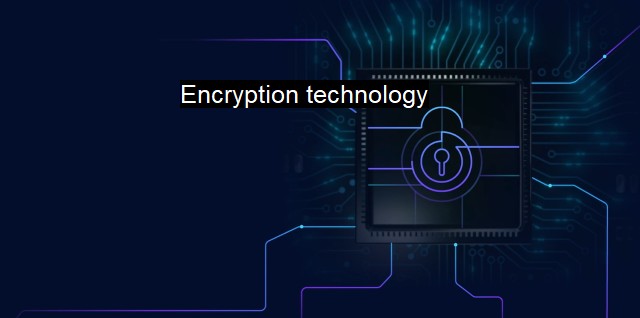What is Encryption technology?
Revolutionizing Cybersecurity: The Crucial Role of Encryption Technology in Protecting Sensitive Data and Preventing Data Breaches
Encryption technology is the science of establishing secure communication in the presence of third parties, which are sought to be kept off from gaining access to the information being exchanged. It essentially involves converting readable plaintext into unreadable ciphertext so that only authorized entities, typically the sender and receiver, can render the information intelligible again, by performing a reversing process known as "decryption". This scrambling of data fuels much of the modern information systems, availing of the promise that the data which leave one computer reach another in undecipherable clusters and unassumable gibberish.In terms of cybersecurity and antivirus, encryption serves a foundational role. It foils the attempts of hackers and cybercriminals in several rather sophisticated ways. Buckets of personal or classified information traversing the ether of the internet can be intercepted by malicious actors. encryption constitutes the provision of that information not in natural language but in a covertly eloquent format only to be Portable encrypted and decrypted using complex mathematical algorithms under the cover of secret encryption keys.
For instance, if a sensitive file is encrypted and subsequently intercepted during transit, the file would appear as strenuously abstruse text. It remains incomprehensible and therefore unusable unless the attacker possesses the relevant encryption key. Even then, the attacker is required to know the specific encryption algorithm employed in its encryption. Tough encryption technologies can employ keys of considerable length -- sometimes stretching into hundreds of characters, which on donning them as large numbers, opens up a realm of possible combinations, virtually making brute-forcing, or guessing the encryption key, a miserably unproductive task.
Not just conferring security to data-in-transit, encryption also extends this vouchsafing to data-in-rest, that is, data that resides on an engineered system. By encrypting personal documents, sensitive system files, or databases on a device, unauthorized access can be nipped from gaining access even if the device was physically seized.
Encryption is eagerly utilized in antivirus programs. Typically a virus works by infiltrating target code, lying dormant until a condition triggers its activation, thereby executing its malicious outcome, and/or championing auto-replication to infest other systems. High-level antiviruses preemptively accord protection to vulnerable regions of the computer by compiling the data therein into securely packaged homogenous blocks. With their interiors encrypted and their exteriors bullet-proofed with multi-authentication security checks, ensuring access or infiltration is convincingly hard, thereby breaking the decamp of many-a-virus. virus detection made in real-time can be quarantined into secure vaults through encryption; pit-stop halting the propagation and activating a diffusionless chain reaction concealing their active presence.
In spite of encryption offering formidable security benefits on the information scale, one should keep sight of its limitations. Such as the fact, encryption cannot prevent on-the agronomic or physical scale; the introduction of malicious code or the unauthority retrieval of encrypted data still reveals an as-yet-unencrypted state. Finding the fine line balance between encryption and restriction, particularly with regard to access controls or backups, can also be challenging. Hence, placing reliable encryption technologies and crafting strong policies always goes hand-in-hand with other adjunct security measures to form a good defense protocol.
Encryption technology dignifies global business continuity and ascertains the fostering of qualified trust for consumers online. In a cyber-world deluged with mushrooming security breaches propelling alarming cybersecurity figures; through robust linkages, unwavering bulwarks, portable forays, and measurable incursions in a world of e-passages and e-barriers, encryption paves a way to a more secure cyberspace.

Encryption technology FAQs
What is encryption technology?
Encryption technology is a method of securing data by converting it into a code that can only be read by authorized individuals or systems. It is used to protect sensitive information from unauthorized access, such as personal information, financial data, and confidential communications.How does encryption technology work in cybersecurity?
Encryption technology works in cybersecurity by converting plain text into cipher text using an algorithm and a key. The algorithm scrambles the text, and the key is needed to unscramble it. This ensures that only authorized individuals or systems with the key can access the original text.Why is encryption technology important for antivirus software?
Encryption technology is important for antivirus software because it helps to protect against malware and other cyber threats that may try to steal sensitive information. By encrypting data, even if it is intercepted, it remains unreadable to unauthorized individuals or systems. This makes it more difficult for attackers to access sensitive information, reducing the risk of data breaches and cyber attacks.What are some common types of encryption technology used in cybersecurity?
Some common types of encryption technology used in cybersecurity include symmetric encryption, asymmetric encryption, and hashing. Symmetric encryption uses a single key to encrypt and decrypt data, while asymmetric encryption uses two keys – one for encryption and one for decryption. Hashing is a one-way encryption method that converts data into a fixed-length string of characters. These encryption methods are often used in combination to provide multiple layers of security.| | A | | | B | | | C | | | D | | | E | | | F | | | G | | | H | | | I | | | J | | | K | | | L | | | M | |
| | N | | | O | | | P | | | Q | | | R | | | S | | | T | | | U | | | V | | | W | | | X | | | Y | | | Z | |
| | 1 | | | 2 | | | 3 | | | 4 | | | 7 | | | 8 | | |||||||